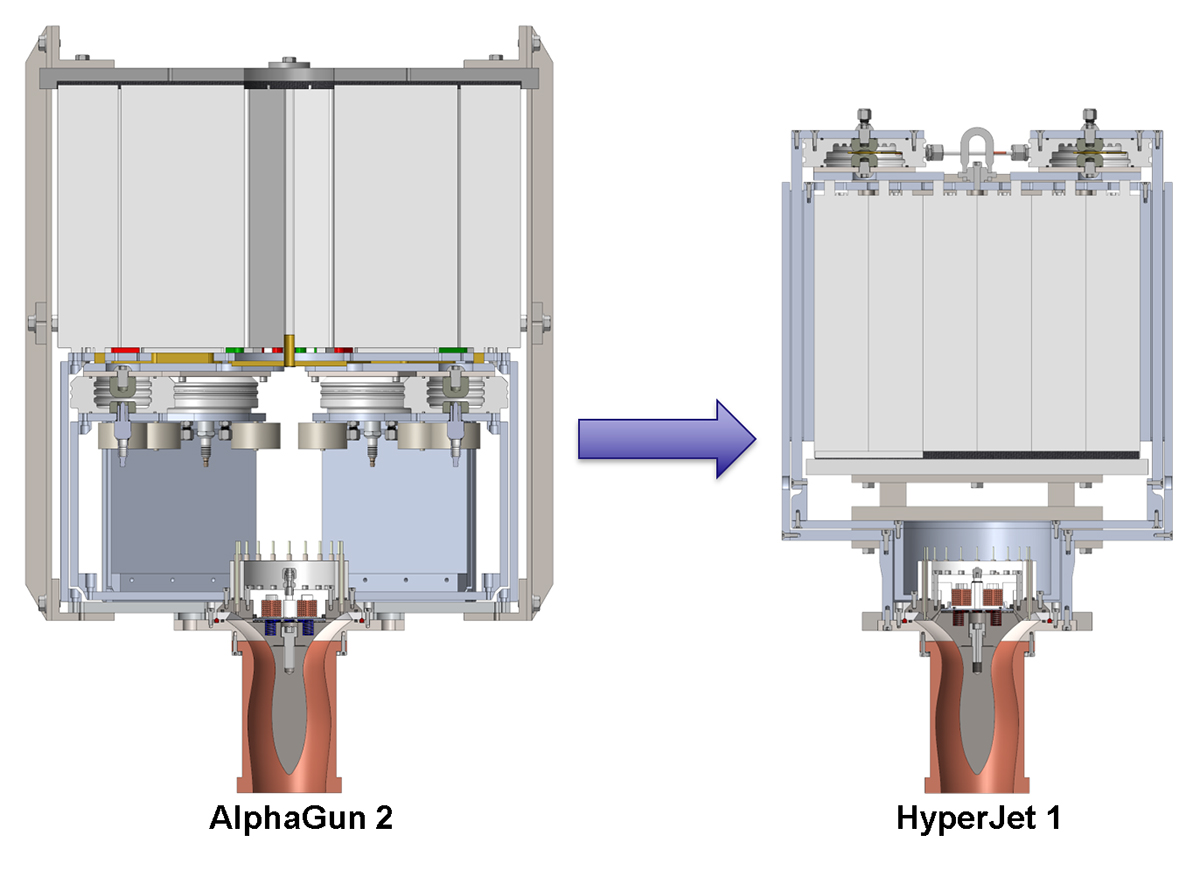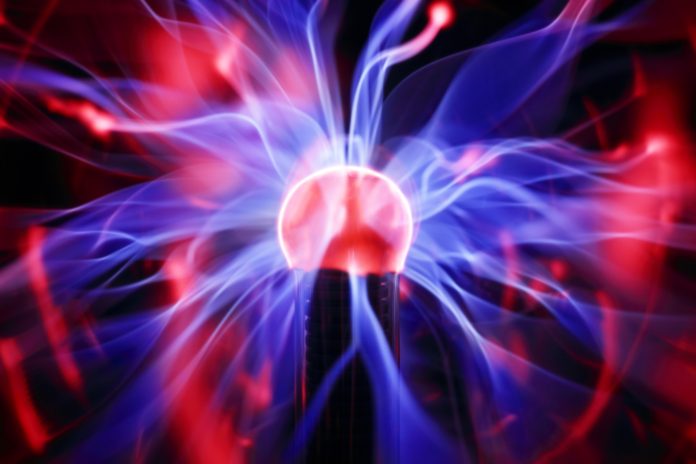C. Francis Thio and F. Douglas Witherspoon, HyperJet Fusion Corporation, provide an update on the progress on Plasma-Jet-Driven Magneto-Inertial Fusion
In this article, we continue our reporting on the progress made on the fusion approach, plasma-jet driven magneto-inertial fusion (PJMIF), which we began in the last of these series of articles [1]. A review of the progress made in the development of the plasma gun needed by PJMIF is given in [2]. Under the ARPA-E ALPHA program launched in 2015 [3], a plasma gun called the ALPHA2gun was developed. The plasma gun development has experienced three development cycles. The first cycle was undertaken with a series of gas valves culminating in Revision 9 (Rev9) using the ALPHA2gun [4].
The second cycle of development introduced Revision 10 (Rev10) of the gas valve, which had substantially improved performance characteristics over the first 9 versions in terms of precision gas mass metering, the speed of opening and closing, reliability, and repeatability. The third cycle of the development of the plasma gun (HJ1) is near completion [5]. Final tuning of the gun is in progress.
In 2016-2018, multiple-gun operations to launch and merge up to seven jets to form a conical section of the plasma liner was performed using the second-generation gun (Alpha2Gun) equipped with the Rev10 gas valve at the Los Alamos PLX-α facility. High-speed framing end-on CCD images of the six Jets merging were acquired, samples of which are shown in Figure 1(a). The images show clearly the formation of primary shocks when the jets first merge. The shocked region of the jet spreads laterally, and soon the shock processes the entire jet. The shocked plasma flows proceed to merge and produce secondary shocks which process the plasma in a similar way as the primary shocks, thus resulting in a cascade of shocks.
This phenomenology was expected theoretically. Computer simulations of the jet merging dynamics agree well with the experimental results as shown in Figure 1(b). Reasonable agreement between the computer simulations and the experimental results is obtained when 10% random mass variations and 1 µs random timing variations in the arrivals of the jets are introduced into the computer simulations.
The shock cascade raises an important physics issue. The shocks heat up the plasma liner, increasing its internal pressure, which resists the self-compression of the liner, thus reducing its efficacy in compressing the target plasma when it is used to implode a target plasma. A dimensionless quantity that may be used to gauge the severity of this effect is the Mach number, which is the ratio of the plasma liner flow speed to its internal sound speed. The heating of the plasma liner raises its internal sound speed, thus lowering the Mach number of the flow.


We found indeed that the rate of cooling of the ions by the electrons was sufficiently fast for the ions to recover its Mach number from a temporary depression during the traverse of the plasma liner towards the centre before it was expected to engage with the target in an actual liner-on-target implosion in a typical PJMIF scenario [7, 8].
Over the last 12 months, HyperJet Fusion has been engaged in the development of a third-generation plasma gun (HJ1), introducing the following new features [5]:

The footprint and volume of the capacitor module driving the gun is considerably reduced going from Alpha2gun to HJ1 as shown in Figure 2. This is necessary in order to field all 36 guns on the PLX tank. The space between the transmission plates in the manifold is completely filled with a solid insulator, thus, providing robust and reliable electrical insulation without any voids, preventing any spurious arcing breakdowns in the transmission manifold. The tighter configuration also results in lowering the internal inductance of the transmission manifold. We expect that, as a result of the lower parasitic inductance, HJ1 should have higher electric-to-kinetic efficiency.

The gun makes use of a gas valve to dispense working gas into the gun. The gas valve is opened by an electromagnetic propulsion subsystem consisting of a drive coil and an aluminium flyer plate (a coilgun). To open the gas valve, a large pulse of electrical current is passed through the drive coil, which induces a large eddy current in the flyer plate. The drive current in the coil and the induced eddy current in the flyer plate repels each other giving rise to the propulsive force that opens the valve.
The self-inductance in the drive coil in HJ1 is about 20 times smaller than in Alpha2gun, leading to a 10-fold increase in the electric-to-kinetic efficiency. Consequently, the capacitor bank of about 1 kilo-joule per gas valve that was required to drive the gas valves in Alpha2gun is reduced to only 100 joules, which can be supplied by a capacitor module that can be packed with each individual gun.
The drive coil in HJ1 is a single-plane, axisymmetric coil that can be wound and placed in the gas valve body with a high degree of geometry precision with respect to the flyer plate (Figure 3). The initial gap between the top of the drive coil and the flyer plate is tightly controlled, leading to very little variations in the mutual inductance between the drive coil and the flyer plate from valve to valve. The mutual inductance is the electrical parameter that determines the repulsive force between the drive coil and the flyer plate. Small adjustments to the circuit parameters for the individual coil of each gun will be sufficient to compensate for any electrical and mechanical variations from valve to valve. A dedicated gas-valve test stand to fine tune, calibrate and qualify each gas valve for all the 36 guns have been developed. Improvement in gun-to-gun repeatability of the gas valve is expected.
To prepare the initial neutral gas slab to accept the main current pulse, the gas slab needs to be pre-ionized. In HJ1, we introduce for the first time a new pre-ionization technique for plasma guns based on a self-switching glow-like discharge (Figure 3(c)) [5]. Eliminating the switch simplifies considerably the logistics of implementing the 36-gun plasma liner experiment. Furthermore, the new pre-ionization system is two-fold more efficient energy-wise than that used in Alpha2gun, allowing a smaller capacitor to drive the pre-ionization, small enough for the capacitor to be packed as part of the gun. However, the technique appears to have the tendency to trigger the main current discharge prematurely. We are in the process of troubleshooting the problem.
A new closing switch for the main discharge has been developed that uses a much more efficient triggering mechanism based on the field-distortion configuration. The field-distortion trigger uses only 15 J of energy per gun compared with 250 J of energy per gun in the Alpha2gun. This also eases the logistics burden of fielding the 36-gun plasma liner experiment [5]. Production of the 36 guns is underway.
References
- Y. C. F. Thio and F. D. Witherspoon, Open Access Government, October 3, https://www.openaccessgovernment.org/plasma (2018).
- Y. C. F. Thio et al., Plasma-Jet-Driven Magneto-Inertial Fusion (PJMIF), Fusion Science and Technology, 2019, DOI: 10.1080/ 15361055.2019.1598736
- P. McGrath, Fusion Power Associates Annual Meeting, Dec 2017, Washington D.C., USA (2017).
- S. C. Hsu, S. J. Langendorf, K. C. Yates, J. P. Dunn, S. Brockington, A. Case, E. Cruz, F. D. Witherspoon, M. A. Gilmore, J. T. Cassibry, R. Samulyak, P. Stoltz, K. Schillo, W. Shih, K. Beckwith, and Y. C. F. Thio, IEEE Trans. Plasma Sci., 46, 99, 1951 (2018).
- Y. C. F. Thio, F. D. Witherspoon, S. Brockington, A. Case, E. Cruz, and M. Luna, Bull. Amer. Phys. Soc., DPP18, 001959 (2018).
- W. Shih, R. Samulyak, S. C. Hsu, S. J. Langendorf, K. C. Yates, and Y. C. F. Thio, Phys. Plasmas, 26, 032704 (2019).
- S. J. Langendorf, K. C. Yates, S. C. Hsu, C. Thoma, and M. Gilmore, Phys. Rev. Lett., 121, 185001 (2018).
- K. C. Yates, S. Langendorf, and et al., Bull. Amer. Phys. Soc., DPP18, 000943 (2018).
Please note: This is a commercial profile
Dr Y. C. Francis Thio
CEO and Chief Scientist
HyperJet Fusion Corporation











